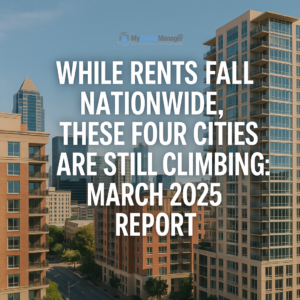After years of relentless rent hikes across the U.S., tenants are finally seeing some relief. March 2025 marked the 20th straight month of national year-over-year rent declines. According to Realtor.com, the median asking rent for 0–2 bedroom units in the 50 largest metros was $1,694, a 1.2% drop compared to March 2024. This trend reflects continued cooling in the rental market, driven in part by a rebound in apartment construction, increased supply, and slowing household formation.
But this relief isn’t reaching everyone. In a surprising twist, four major U.S. cities saw significant rent increases suggesting that local dynamics are still fueling upward pressure in certain areas.
What’s Behind the National Decline?
Several key factors are contributing to the rent drops nationwide:
- Surge in Multifamily Construction: Developers ramped up apartment construction in 2021–2022, and those units are now hitting the market. Increased supply is giving renters more options and forcing landlords to price more competitively.
- Slower Household Formation: Economic uncertainty and shifting lifestyle preferences are causing fewer people to form new households, reducing demand.
- Renters Hitting Affordability Ceilings: With wages struggling to keep up with housing costs, many renters have reached their budget limit leading to increased vacancies in overpriced markets.
The Cities Where Rents Are Still Rising
Despite the national downtrend, four cities bucked the trend and saw double-digit increases in median asking rent from March 2024 to March 2025:
-
Cincinnati, OH
-
Year-over-year increase: +11.9%
-
Median rent: $1,393
-
Why? Cincinnati’s job market and economic growth are attracting newcomers, while new apartment construction hasn’t kept pace with demand.
-
-
Indianapolis, IN
-
Year-over-year increase: +10.8%
-
Median rent: $1,304
-
Why? A growing tech sector and rising in-migration are fueling demand. With fewer new units coming online, renters are competing for limited space.
-
-
Milwaukee, WI
-
Year-over-year increase: +10.1%
-
Median rent: $1,467
-
Why? Milwaukee’s supply chain issues and stalled multifamily development are keeping inventory tight, driving prices up.
-
-
Minneapolis-St. Paul, MN
-
Year-over-year increase: +10.0%
-
Median rent: $1,528
-
Why? The Twin Cities continue to draw professionals and young families, outpacing new housing supply and putting pressure on the market.
-
These markets highlight how regional economic strength, low housing inventory, and delayed construction can override national trends and lead to continued rent hikes.
A Closer Look by Unit Type
The national rent declines weren’t just broad stroke averages they were consistent across apartment sizes:
-
Studio apartments: $1,407 median rent
-
Down 1.2% from March 2024
-
-
1-bedroom units: $1,577 median rent
-
Down 1.1%
-
-
2-bedroom units: $1,878 median rent
-
Down 1.4%
-
This uniformity suggests that the market correction is widespread yet still highly localized when viewed at the city level.
What Renters Should Know Moving Forward
- Your Local Market Matters Most: While national trends offer helpful context, renters should pay close attention to their city’s job growth, development activity, and vacancy rates.
- Construction Activity Could Shift the Balance: Areas with more new housing coming online will likely see rent stabilization or even further drops while cities with slower permitting or construction delays may see rent spikes.
- Affordability Isn’t Guaranteed: Even in declining markets, rents are still well above pre-pandemic levels. Budgeting remains critical.
- Consider Timing Your Move: With more supply entering the market, renters may find better deals in the coming months particularly in markets that overbuilt during the boom.
Final Thoughts
The national rent drop is good news for many, but it’s not a universal story. As markets like Cincinnati and Indianapolis experience double-digit increases, it’s clear that housing affordability in 2025 remains a local issue shaped by development policies, migration patterns, and economic strength.
Understanding the story behind your city’s rental trends is more important than ever.
Source:
Realtor.com. “Rents Have Surged in These 4 Major Cities Here’s Why”

